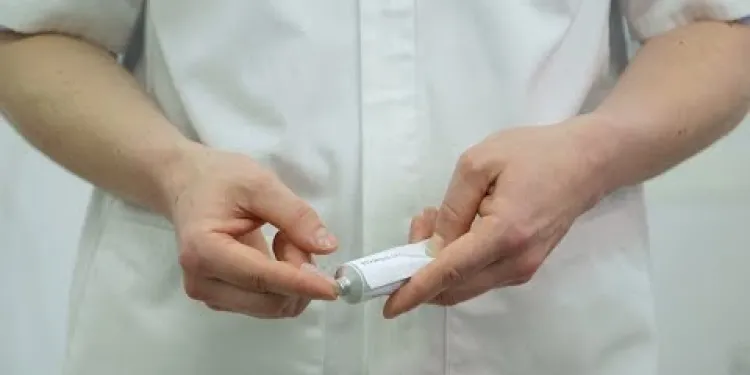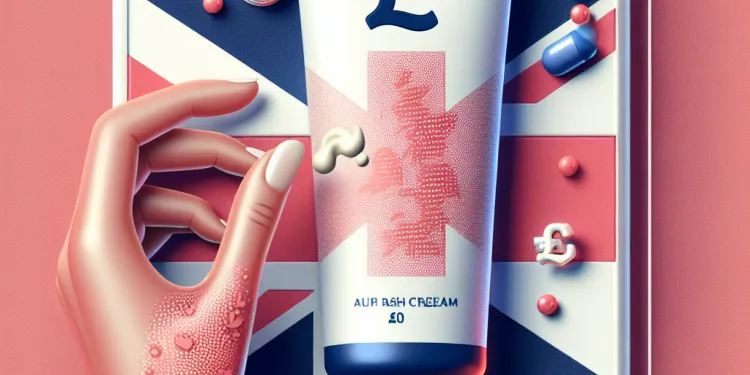Find Help
More Items From Ergsy search
-

How to use topical steroids
Relevance: 100%
-

Steroid cream see Topical corticosteroids
Relevance: 92%
-

What are topical treatments for psoriasis?
Relevance: 46%
-

How are the topics for the HMRC Employer Bulletin chosen?
Relevance: 40%
-

What topics are covered in a first aid course?
Relevance: 34%
-

What treatments are available for eczema?
Relevance: 25%
-

What topics does the HMRC Employer Bulletin cover?
Relevance: 24%
-

Managing and treating your child's eczema
Relevance: 19%
-

What is eczema? General Information
Relevance: 17%
-

What treatment options are available for psoriasis?
Relevance: 15%
-

How is impetigo treated?
Relevance: 14%
-

What substances are commonly associated with drug offences?
Relevance: 14%
-

Eczema - Your child's appointment | Dermatology | Paediatrics
Relevance: 13%
-

What forms does CBD come in?
Relevance: 13%
-

What is postherpetic neuralgia?
Relevance: 13%
-

How to treat psoriasis
Relevance: 12%
-

How to apply wet wraps
Relevance: 12%
-

What is the HMRC Employer Bulletin?
Relevance: 12%
-

Does the HMRC Employer Bulletin cover changes in employment law?
Relevance: 12%
-

How to treat an insect bite or sting | NHS
Relevance: 11%
-

What is full-spectrum CBD?
Relevance: 11%
-

Are there first aid courses for pets?
Relevance: 11%
-

Where can I find the HMRC Employer Bulletin?
Relevance: 11%
-

Treating scalp psoriasis
Relevance: 11%
-

Where can I learn first aid online?
Relevance: 11%
-

Is there a cure for eczema?
Relevance: 11%
-

How long does it take for impetigo to heal?
Relevance: 11%
-

Is feedback allowed on the HMRC Employer Bulletin?
Relevance: 11%
-

Can cortisol levels be measured?
Relevance: 10%
-

Is there a connection between cortisol and the immune system?
Relevance: 10%
-

How can I prepare for the DVSA Theory Test?
Relevance: 10%
-

Is the HMRC Employer Bulletin free?
Relevance: 10%
-

How long does it take for CBD to work?
Relevance: 10%
-

Is training available for coaches to help prevent concussions?
Relevance: 10%
-

Tennis Elbow
Relevance: 10%
-

What is cortisol?
Relevance: 10%
-

What treatments are available for shingles?
Relevance: 10%
-

Can cortisol levels impact mood and mental health?
Relevance: 9%
-

How is cortisol regulated in the body?
Relevance: 9%
-

What is the DVSA Theory Test?
Relevance: 9%
How to Use Topical Steroids
Understanding Topical Steroids
Topical steroids, also known as corticosteroid creams or ointments, are medications applied to the skin to reduce inflammation and treat various skin conditions. They are commonly prescribed for conditions such as eczema, psoriasis, and dermatitis. These medications come in different strengths and formulations, so it's crucial to follow your healthcare provider's instructions carefully.Application Guidelines
1. **Wash and Dry the Affected Area**: Before applying a topical steroid, ensure the affected skin is clean and dry. Gently wash the area with mild soap and water, then pat it dry with a clean towel. 2. **Apply a Thin Layer**: Squeeze a small amount of the steroid cream or ointment onto your fingertip. Apply a thin layer over the affected area, gently rubbing it in until it is evenly distributed. Avoid using large amounts, as this can increase the risk of side effects. 3. **Frequency**: Follow your healthcare provider’s instructions on how often to apply the medication. Typically, topical steroids are applied once or twice a day. Do not exceed the recommended dosage or duration to prevent potential side effects. 4. **Avoid Sensitive Areas**: Avoid applying topical steroids to sensitive areas such as the face, groin, or underarms unless specifically directed by your healthcare provider.Duration of Treatment
Topical steroids should be used for the shortest duration necessary to achieve the desired effect. Prolonged use can lead to skin thinning, stretch marks, or other adverse effects. Your healthcare provider will guide you on how long to use the medication based on your specific condition.Monitoring and Side Effects
1. **Monitor Your Skin**: Keep an eye on the treated area for any signs of improvement or adverse reactions. If your condition does not improve or worsens after a few days of treatment, contact your healthcare provider for further advice. 2. **Common Side Effects**: Be aware of potential side effects such as skin thinning, stretch marks, or a burning sensation at the application site. If you notice any severe reactions like allergies or worsening of the condition, seek medical attention immediately.Special Considerations
1. **Children and Elderly**: Extra caution should be taken when using topical steroids in children and the elderly, as their skin may be more susceptible to side effects. Always use the lowest effective dose and consult a healthcare provider for guidance. 2. **Pregnancy and Breastfeeding**: If you are pregnant or breastfeeding, discuss with your healthcare provider before using topical steroids to ensure they are safe for you and your baby.Conclusion
Topical steroids can be highly effective in managing skin conditions when used correctly. Always follow your healthcare provider’s instructions, apply only the prescribed amount, and monitor for any side effects. Proper use will help you achieve optimal results while minimizing potential risks. For personalized advice or if you have any concerns, do not hesitate to consult your healthcare professional in the United Kingdom.How to Use Skin Cream Medicine
What Are Skin Cream Medicines?
Skin cream medicines are also called topical steroids. They help make swollen or itchy skin feel better. Doctors give them for things like eczema, psoriasis, and dermatitis. These creams have different strengths, so you must do what your doctor tells you.How to Put on the Cream
1. **Wash and Dry Your Skin**: Wash the sore area with mild soap and water. Dry it gently with a towel. 2. **Use a Little Bit**: Put a small amount of the cream on your fingertip. Spread it gently and thinly over the sore skin. Do not use too much because it can cause problems. 3. **How Often to Use**: Your doctor will tell you how many times to put on the cream, like once or twice a day. Do not use more than your doctor says. 4. **Avoid Special Areas**: Do not put the cream on sensitive places like your face, groin, or underarms unless your doctor says it's okay.How Long to Use It
Use skin cream medicine only as long as needed. Using it too long can cause problems like thin skin or stretch marks. Your doctor will tell you how long to use the cream.Watch for Side Effects
1. **Check Your Skin**: Look at the skin you are treating. If it doesn't get better, or if it gets worse, talk to your doctor. 2. **Possible Problems**: You might notice things like thinner skin or a burning feeling where you apply the cream. If you have a strong reaction, see a doctor right away.Things to Be Careful About
1. **For Kids and Older People**: Be extra careful with children and older people because their skin is delicate. Use only what the doctor says. 2. **Pregnant or Breastfeeding**: If you are pregnant or breastfeeding, ask your doctor if it's okay to use the cream.Summary
Skin cream medicines can help with skin problems if used correctly. Listen to your doctor, use only the amount they say, and watch out for side effects. For help or questions, talk to your doctor.Frequently Asked Questions
What are topical steroids?
Topical steroids are medications applied directly to the skin to reduce inflammation and treat various skin conditions, such as eczema, psoriasis, and dermatitis.
How do topical steroids work?
Topical steroids work by reducing inflammation and suppressing the immune response in the skin, helping to alleviate symptoms like redness, swelling, and itching.
How should I apply topical steroids?
Apply a thin layer of the topical steroid to the affected area, gently rubbing it in until it's absorbed. Always follow the instructions provided by your healthcare provider or the medication's leaflet.
How often should topical steroids be used?
The frequency of application depends on the specific steroid and the condition being treated. Typically, topical steroids are applied once or twice daily. Follow your healthcare provider’s instructions.
Is it safe to use topical steroids on my face?
Topical steroids can be used on the face, but with caution. They should only be used under the guidance of a healthcare provider, as the facial skin is more delicate and prone to side effects.
Can topical steroids be used on children?
Yes, but it's essential to use the lowest effective strength and for the shortest duration necessary. Always consult a healthcare provider before using topical steroids on children.
What are the side effects of topical steroids?
Side effects may include skin thinning, stretch marks, and increased susceptibility to infections. Long-term use can lead to more severe effects, so follow the prescribed usage.
Can I use topical steroids on broken skin?
Avoid using topical steroids on broken skin unless advised by a healthcare provider, as it can increase the risk of infection and further irritation.
What should I do if I miss a dose?
If you miss a dose, apply it as soon as you remember. If it's almost time for the next dose, skip the missed one and continue with your regular schedule. Do not apply double doses.
Can I use moisturisers with topical steroids?
Yes, you can use moisturisers. Apply them before or after the steroid, depending on the advice from your healthcare provider. Generally, applying a moisturiser 30 minutes after the steroid can be beneficial.
How long can I use topical steroids safely?
The duration of safe use depends on the steroid's strength and the condition being treated. Typically, treatment is limited to a few weeks. Consult your healthcare provider for specific guidance.
Can I stop using topical steroids abruptly?
It's not recommended to stop using topical steroids suddenly, especially after long-term use, as it may cause a flare-up. Gradually tapering off under medical supervision is advisable.
Are there any alternatives to topical steroids?
Yes, there are non-steroidal treatments such as topical calcineurin inhibitors, moisturisers, and other medications. Consult your healthcare provider to explore alternative options.
Can I use topical steroids if I am pregnant or breastfeeding?
Consult your healthcare provider before using topical steroids during pregnancy or breastfeeding. They can advise on the safest options and appropriate usage.
Where should I store my topical steroids?
Store topical steroids in a cool, dry place away from direct sunlight and out of reach of children. Follow any specific storage instructions provided in the medication's leaflet.
What are creams with steroids?
Creams with steroids are medicines you put on your skin. They help to stop itching and make rashes go away.
If your skin has a rash or is very itchy, a doctor might give you a cream with steroids.
The cream stops redness and swelling. It helps your skin feel better.
Tips:
- Ask an adult to help you when using the cream.
- Read the instructions on the cream box.
- If the cream hurts your skin, tell someone right away.
Topical steroids are medicines you put on your skin. They help to make the skin less red and puffy. They are used to help with skin problems like eczema, psoriasis, and dermatitis.
How do creams with steroids work?
Steroid creams are special creams that help make skin problems better. They reduce redness, itching, and swelling. Be sure to use them as the doctor tells you.
If you find reading hard, try using pictures or ask someone to read the information with you.
Topical steroids help make your skin feel better. They do this by calming down redness, swelling, and itching. They also help cool down the skin's reaction.
How do I use skin cream with steroids?
Here is how you can use the cream:
- Wash your hands with soap and water.
- Put a little bit of cream on the sore or itchy spot.
- Rub it in gently.
- Wash your hands again after putting on the cream.
- Use it as many times as the doctor says.
If you need help, ask a grown-up or someone you trust to show you how. You can also use reminder notes or alarms to help you remember when to put on the cream.
Put a small amount of the steroid cream on your skin where it hurts. Rub it in gently until it disappears. Always do what your doctor says or read the instructions on the box.
How often should you use skin creams with steroids?
Doctors decide how often you should use the cream. Usually, it is once or twice a day.
If you are not sure, ask your doctor or nurse.
Get help if needed. You can use pictures or videos to understand better.
How often you use the cream depends on what the cream is and what you are using it for. Usually, you put the cream on one or two times a day. Always do what your doctor tells you.
Can I use skin cream medicine on my face safely?
You can use a special cream called topical steroids on your face, but you need to be careful. Only do this if a doctor or nurse tells you it’s okay, because the skin on your face is very soft and can have problems easily.
Can children use skin creams with steroids?
We need to be careful when using steroid creams on kids' skin. Always ask a doctor first. The doctor can tell you if it is safe and how much to use. Some creams might not be okay for little kids.
Support tools:
- Ask a doctor or a nurse for help.
- Read the instructions on the cream's box.
- Talk to the doctor about how long to use the cream.
Yes, you can use it, but use the smallest amount that works and stop as soon as you can. Talk to a doctor before you use these creams on kids.
What can happen if you use steroid cream on skin?
Steroid cream can help when your skin is red and itchy. But sometimes it can cause problems. Here are some things that might happen:
- Your skin might get thin.
- You might get more hair where you use the cream.
- Your skin might change color.
- You could get pimples.
- Your skin might get red again if you use it for too long.
If you're not sure about using steroid cream, ask a doctor. It helps if you follow the doctor's advice and use the cream the right way. You can use pictures and tools to remember how and when to use it.
Using this medicine might make your skin thin, cause stretch marks, or make it easier to get infections. If you use it for a long time, the effects might get worse. Always use the medicine as your doctor tells you.
Can I use skin cream on cuts or sore skin?
If your skin has cuts or is sore:
- Ask a doctor or nurse before using any cream.
- Some creams might make it worse.
It is important to:
- Keep skin clean and dry.
- Wash hands before using cream.
Ask someone for help if you are not sure. A picture chart can also help you remember what to do.
Don't use skin creams with steroids on cuts or sores unless a doctor says it's okay. It can make infections worse and irritate the skin more.
What to Do If You Forget to Take Your Medicine?
If you forget to take your medicine, don't worry! Here are some easy steps to follow:
- Check the Instructions: Look at the paper that comes with your medicine. It might tell you what to do if you forget a dose.
- Use Reminders: Set an alarm or ask someone to remind you to take your medicine next time.
- Ask for Help: If you're not sure what to do, you can call your doctor or pharmacist for advice.
Remember, it's important to listen to the advice from your doctor or the person who gave you the medicine.
If you forget to use your medicine, use it as soon as you remember. If it's almost time for your next dose, don't use the one you missed. Just use the next dose at the regular time. Do not use extra medicine to make up for the missed dose.
Tip: You can set an alarm or use a pill organizer to help you remember.
Can I put creams and steroid medicines on my skin?
Yes, you can use creams to keep your skin soft. Put the cream on before or after the medicine cream. Ask your doctor what is best. A good idea is to wait 30 minutes after the medicine to put on the soft cream.
How long can I use cream medicine safely?
Cream medicine from the doctor helps your skin. But too much can be bad.
- Listen to your doctor or nurse. They will tell you how much to use and when to stop.
- Usually, you don’t use it for a long time. Only for a few weeks or months.
- If you feel worried or your skin gets worse, talk to your doctor or nurse.
Here are some tools that can help you remember:
- Make a chart to track when you put on the cream.
- Set an alarm so you remember to put it on.
Always ask for help if you’re not sure what to do.
How long you can use a steroid safely depends on how strong it is and what you are using it for. Most of the time, you should only use it for a few weeks. Ask your doctor for advice that is right for you.
Can I stop using skin creams with steroids all at once?
If you use a cream with steroids on your skin, don't stop all at once. It can make your skin worse. It's better to use less and less over time. A doctor can help you do this safely.
Can I use something instead of skin cream with steroids?
Yes, there are different treatments that do not use steroids. These include special creams like topical calcineurin inhibitors, moisturisers, and other medicines. You should talk to your doctor to find out what other options are best for you.
Can I use skin creams with steroids if I am pregnant or breastfeeding?
If you have a baby growing in your tummy, or if you are feeding your baby with your milk, you might want to use skin cream with steroids.
It's important to talk to your doctor first. They can tell you if it's safe for you and your baby.
Ask your doctor or nurse questions if you are not sure. You can also ask for help reading about it if you need to. Using pictures or having someone read with you can be helpful too.
Talk to your doctor before using creams with steroids when you are pregnant or breastfeeding. They can help you choose the safest creams and show you how to use them properly.
Where should I keep my skin creams?
Here is the easy way to understand where to keep your skin creams:
- Keep your creams in a cool, dry place.
- Make sure they are not in the sun.
- Put them on a high shelf, so little kids can't reach them.
If you need help reading, you can ask an adult to help you. You can also use voice apps to read it to you.
Keep your cream in a cool, dry place. Make sure the sun can't reach it. Keep it where kids can't get it. Read the instructions on the leaflet for more tips on storing it.
Useful Links
- Ergsy carfully checks the information in the videos we provide here.
- Videos shown by Youtube after a video has completed, have NOT been reviewed by ERGSY.
- To view, click the arrow in centre of video.
- Most of the videos you find here will have subtitles and/or closed captions available.
- You may need to turn these on, and choose your preferred language.
- Go to the video you'd like to watch.
- If closed captions (CC) are available, settings will be visible on the bottom right of the video player.
- To turn on Captions, click settings .
- To turn off Captions, click settings again.
More Items From Ergsy search
-

How to use topical steroids
Relevance: 100%
-

Steroid cream see Topical corticosteroids
Relevance: 92%
-

What are topical treatments for psoriasis?
Relevance: 46%
-

How are the topics for the HMRC Employer Bulletin chosen?
Relevance: 40%
-

What topics are covered in a first aid course?
Relevance: 34%
-

What treatments are available for eczema?
Relevance: 25%
-

What topics does the HMRC Employer Bulletin cover?
Relevance: 24%
-

Managing and treating your child's eczema
Relevance: 19%
-

What is eczema? General Information
Relevance: 17%
-

What treatment options are available for psoriasis?
Relevance: 15%
-

How is impetigo treated?
Relevance: 14%
-

What substances are commonly associated with drug offences?
Relevance: 14%
-

Eczema - Your child's appointment | Dermatology | Paediatrics
Relevance: 13%
-

What forms does CBD come in?
Relevance: 13%
-

What is postherpetic neuralgia?
Relevance: 13%
-

How to treat psoriasis
Relevance: 12%
-

How to apply wet wraps
Relevance: 12%
-

What is the HMRC Employer Bulletin?
Relevance: 12%
-

Does the HMRC Employer Bulletin cover changes in employment law?
Relevance: 12%
-

How to treat an insect bite or sting | NHS
Relevance: 11%
-

What is full-spectrum CBD?
Relevance: 11%
-

Are there first aid courses for pets?
Relevance: 11%
-

Where can I find the HMRC Employer Bulletin?
Relevance: 11%
-

Treating scalp psoriasis
Relevance: 11%
-

Where can I learn first aid online?
Relevance: 11%
-

Is there a cure for eczema?
Relevance: 11%
-

How long does it take for impetigo to heal?
Relevance: 11%
-

Is feedback allowed on the HMRC Employer Bulletin?
Relevance: 11%
-

Can cortisol levels be measured?
Relevance: 10%
-

Is there a connection between cortisol and the immune system?
Relevance: 10%
-

How can I prepare for the DVSA Theory Test?
Relevance: 10%
-

Is the HMRC Employer Bulletin free?
Relevance: 10%
-

How long does it take for CBD to work?
Relevance: 10%
-

Is training available for coaches to help prevent concussions?
Relevance: 10%
-

Tennis Elbow
Relevance: 10%
-

What is cortisol?
Relevance: 10%
-

What treatments are available for shingles?
Relevance: 10%
-

Can cortisol levels impact mood and mental health?
Relevance: 9%
-

How is cortisol regulated in the body?
Relevance: 9%
-

What is the DVSA Theory Test?
Relevance: 9%


